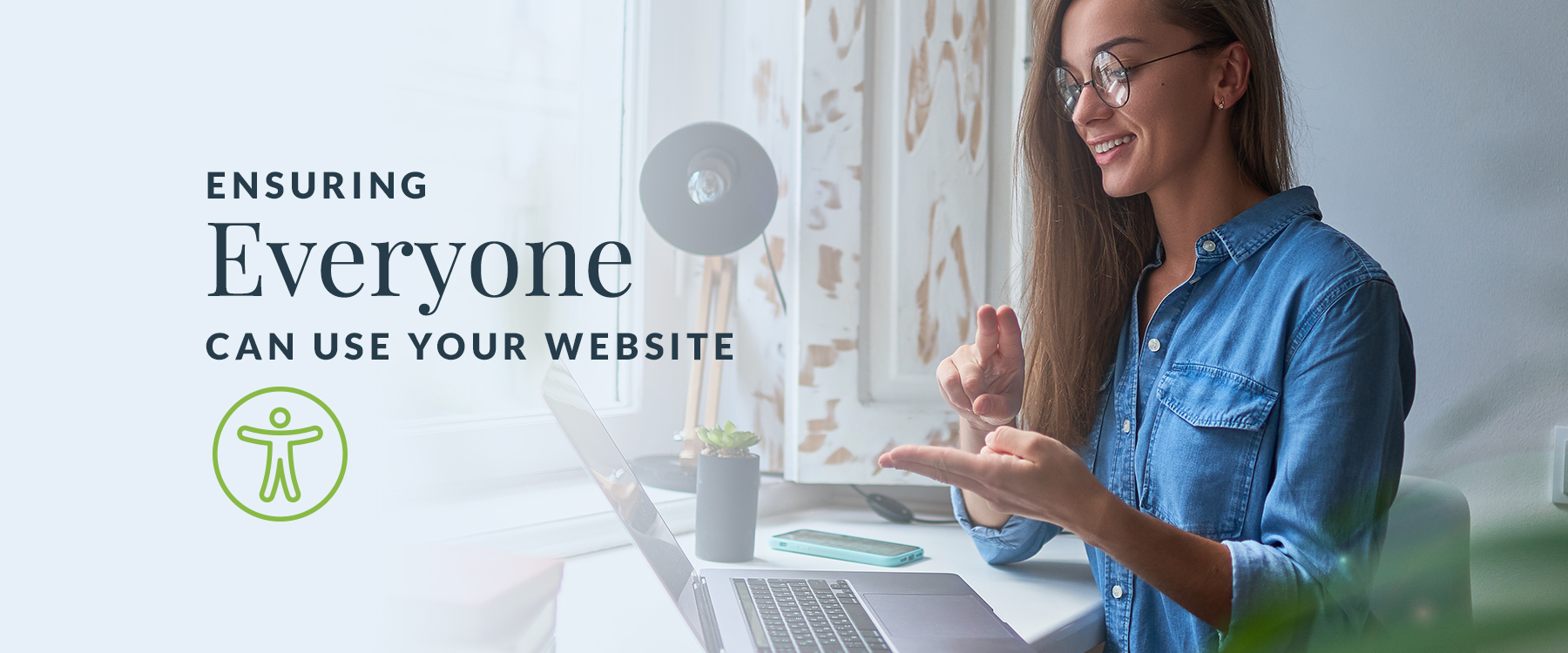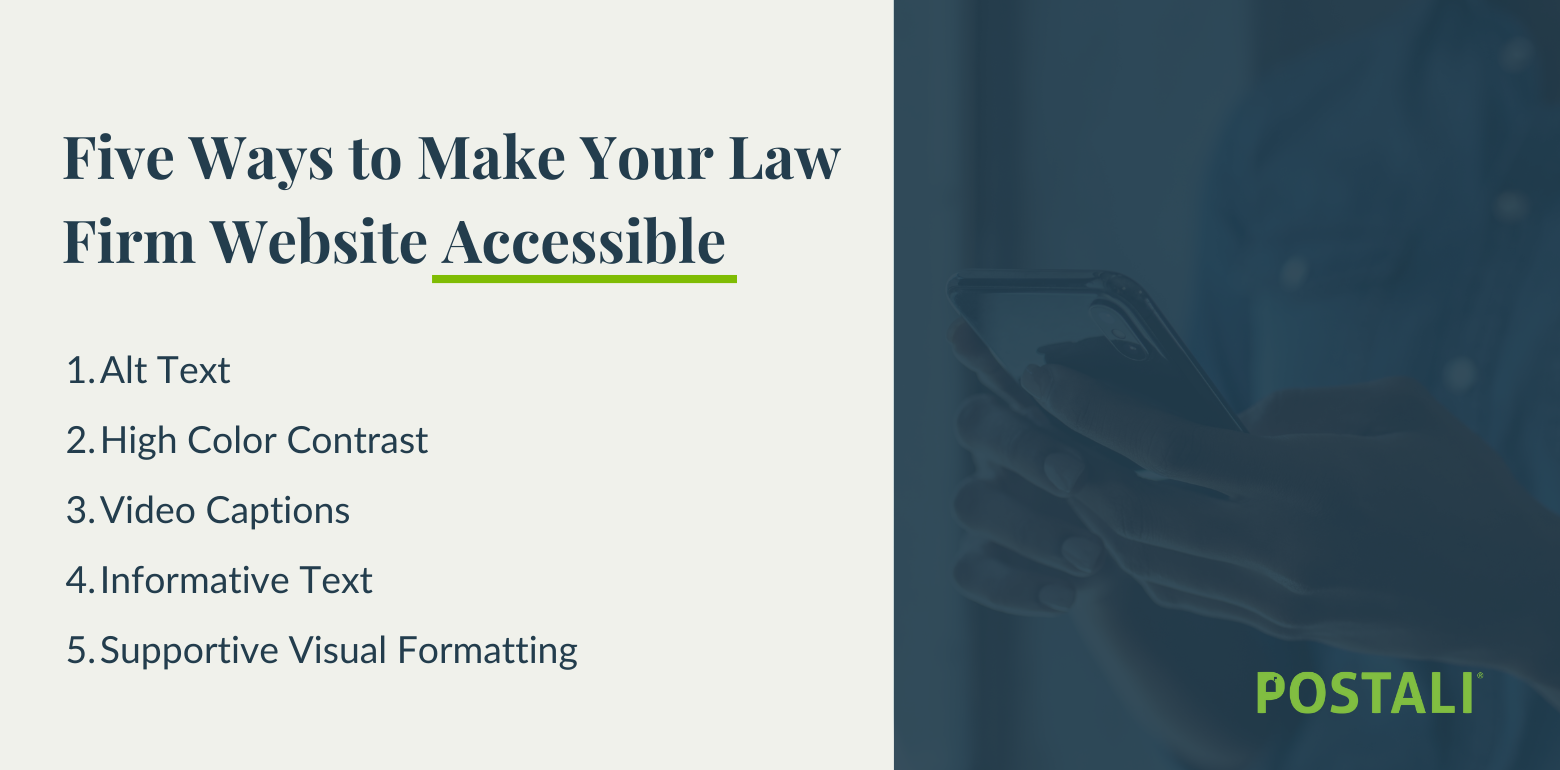Business Strategy & Development, User Experience

Making your website accessible for everyone is easier with Postali.
Does your website provide equal access to every visitor?
Making your website accessible to people with disabilities matters for lots of reasons, starting with this overview from the Web Content Accessibility Guidelines Version 3.0:

We thought that might get your attention – it certainly got ours.
What Is Web Content Accessibility?
People with disabilities process information differently. Accessibility ensures that people with disabilities get the same experience as those who use standard website navigation, such as point-and-click or keyboard-based commands.
For your website to be inclusive for people with disabled visitors, you’ll want to present content that stimulates all the senses, such as:
- Alt text for images – descriptive, audible text so sight-impaired visitors can understand images
- Descriptive link names – allowing easier site navigation
- In-sync captioning – video captions for the deaf or hard of hearing
Your website should give all visitors equal access to your entire site, from submitting a request for consultation to paying their invoice.
Why Web Content Accessibility Matters
Web accessibility ensures that everyone who wants to can access web content no matter their ability or limitation.
Not only is it economically beneficial for your practice, but it’s also the right thing to do. Even more than other types of businesses, law firms have a special obligation to uphold higher moral standards. After all, you’ve made it your life’s work to protect and defend peoples’ Constitutional rights.
Accessibility Expands Your Reach
Inclusive websites let you reach a wider audience. There are 42.5 million disabled people in the U.S. alone. One in five American adults identifies as disabled, according to a Pew Research study. And at some point in their lives, these Americans will search for a lawyer to draw up a Will, file a personal injury lawsuit, or defend themselves from criminal charges.
In other words, everyone – and we mean everyone – Googles for an attorney to hire at some point in their lives. Why not make it as easy as possible for them to find your firm?
Incorporating Accessibility Reduces Legal Risk
Web content accessibility guidelines may soon be mandatory, not voluntary. Lawyers without a fully accessible website might need a lawyer themselves. Government websites are already required to have accessible content, according to Usability.gov.
Accessibility Can Support Your Brand
A fully inclusive website separates you from the competition. Your branding becomes more genuine when you place accessibility at the heart of your webpage. A personal injury or elder law firm can use accessibility as a brand differential from the competition.
How accessible is your current website? Click here for a quick evaluation.
Five Easy Ways to Increase Accessibility
Whether you’re revamping or building a new one, these five tips make your website easier to find and read for people with disabilities.

1. Alt Text
Screen reader users only hear “image” for photos, logos, drawings, charts, and other graphics. You can imagine how disheartening they might be. Alt text – alternative text – creates a richer, more complete experience for sight-impaired visitors.
Use alt text in the mark-up code for simple images. Complex images should have captions or descriptive summaries in an adjoining paragraph.
2. High-Color Contrast
Usability.gov cautions web designers not to rely entirely on color for navigation. When color is used, it should be a clear contrast. Google Support recommends a minimum ratio of 4.5:1 for large text and a 7:1 ratio for other text and images.
3. Captioning for Videos
Captions show a word-by-word transcript of the dialogue and sometimes sound effects or nonspeech features. Captioning helps the deaf and hard of hearing understand and enjoy a video the same way hearing people can.
4. Informative Text
Informative link text helps screen readers find specific pages. “Click here” is not a helpful link text. If you want readers to find your testimonial page, try “Client Reviews” instead.
5. Supportive Visual Formatting
Screen readers may not recognize formatting changes, such as boldface. You can better communicate with blind or sight-impaired visitors by alerting them with “important” or similar text.
Move Up in Organic Search Results
Your accessible website can be a virtual welcome mat for people with disabilities to find you, learn about you, and hopefully, ask for your legal support.
Google is the gold standard in SEO. With small but significant changes in your digital presence, you can move up your listing in organic search results.
Free Accessibility Checkers
Making the web more accessible for disabled visitors is a win-win situation. In our experience, some of the best programs for evaluating and improving your website accessibility won’t cost you a dime to download.
However, you should know that redesigning and manipulating the inner workings of a website is challenging.
Google Lighthouse
Google Lighthouse is an open-source performance developers tool that identifies accessibility issues. Lighthouse scans your website in real-time and then scores it from 0-100. An ideal Lighthouse score is above 90.
WAVE
WAVE is a free resource developed in 2001 by Utah State University. It is provided as a community resource by WebAIM, which stands for “web accessibility in mind.”
W3C Resource Page
If you have the time to conduct a thorough investigation, the WCAG links to over 100 accessibility checkers, each with evaluation tools for specific accessibility needs.
A Disturbing Digital Divide
According to Pew, 72 percent of disabled Americans have high-speed broadband, compared to 78 percent of people without a reported disability. One in four disabled people go online at least once every day. Yet, disturbingly, there is a digital divide among those with disabilities and those without.
A study conducted by Nucleus Research showed that many of the nation’s biggest online retailers have serious accessibility issues. Individual interviews with blind or sight-impaired participants revealed that two-thirds of their digital transactions are never completed because the websites are not accessible.
Avoid Lawsuits for Your Firm and Your Clients
As your legal marketing fiduciary partner, you should know that web accessibility lawsuits continue to grow. In 2023, there were 2,281 website accessibility lawsuits filed in federal court.
Individuals who lack accessibility on their website, mobile app, and software are being held accountable. It’s safe to say that this trend will continue as more consumers demand digital access.

Accessibility Guidelines and Laws
Our website design team helps ensure that your law firm’s site complies with national and international statutes, including:
- Americans with Disabilities Act (ADA)
- Section 508 of the Rehabilitation Act
- European Web Accessibility Directive
- Web Content Accessibility Guidelines (WCAG)
Accessibility Is Ongoing
Accessibility is an ongoing process, not a one-and-done project. Some digital design firms promise a quick fix using an overlay or widget that makes your website appear accessible when it’s not. A façade of accessibility damages your reputation as a law firm that supports equality and inclusivity.
Furthermore, cutting corners on accessibility enhancements can hinder your entire website’s performance, speed, and efficacy.
The best way to create a truly inclusive site is to integrate accessibility from the start. We realize that this isn’t always possible, so we offer accessibility solutions with the least interruption to your live website and virtual services.
We Understand Accessibility
Accessibility may sound like a new thing to you, but we’ve seen it’s impact on consumers first-hand. Although we’re not 100% compliant on all our sites, we continue to push forward with our goal of fully accessible law firm websites every day. We’re always looking out for ways to make our clients gain a competitive edge with regular audits and updates.
We’d welcome the chance to talk about your firm’s accessibility and digital marketing. Reach out today.

Not sure where to begin?
Get started with a marketing audit.




